
Обзор ключевых слов о трафике. Здесь вы можете легко найти ключевые слова и определения, которые вам еще не известны.
More subjects
The Weimaraner (/ˈwaɪmərɑːnər/ VY-mə-rah-nər) is a large dog that was originally bred as a hunting dog in the early 19th century. Early Weimaraners were used by royalty for hunting large game such as boar, bear and deer. As the popularity of large game hunting began to decline, Weimaraners were used for hunting smaller animals like fowl, rabbits and foxes. The Weimaraner is an all-purpose gun dog. The name comes from the Grand Duke of Saxe-Weimar-Eisenach, Karl August, whose court, located in the city of Weimar (now in the state of Thuringia in modern-day Germany), enjoyed hunting. The Weimaraner possesses traits such as speed, stamina, great sense of smell, great eyes, courage, and intelligence. The breed is sometimes referred to as the 'grey ghost' of the dog world originating from its ghostly coat and eye color along with its stealthy hunting style. (Source: Wikipedia.org, CC BY-SA)
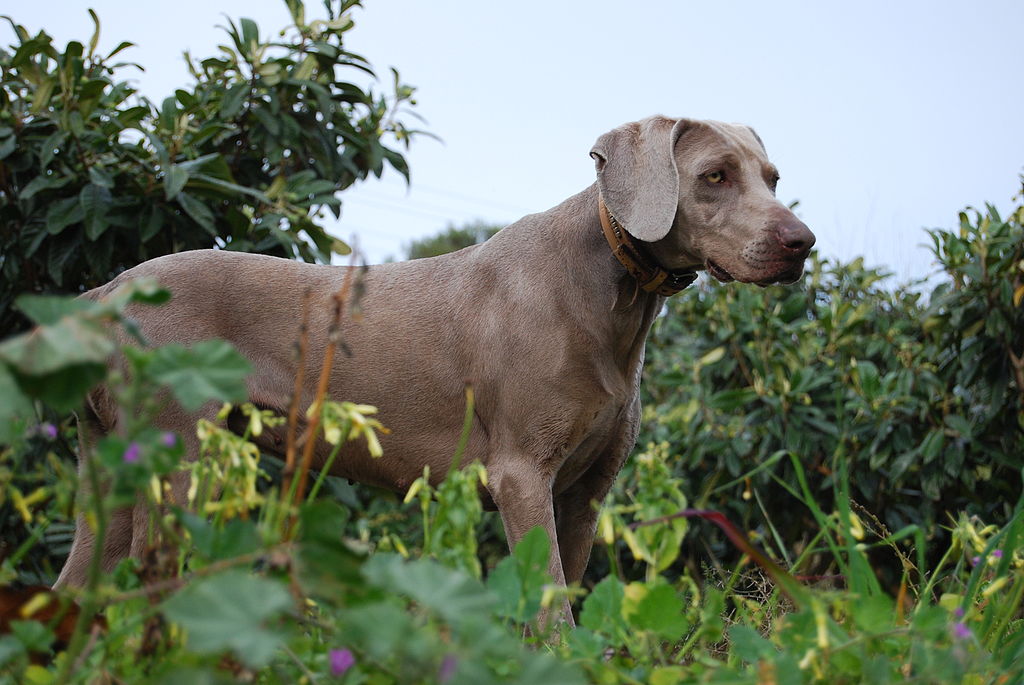 © Wikimedia.org/Salhedine, CC BY-SA
© Wikimedia.org/Salhedine, CC BY-SA
The Welsh Sheepdog (Welsh: Ci Defaid Cymreig, pronounced [kiː ˈdɛvaɪd kəmˈrɛɨɡ]) is a Welsh breed of herding dog of medium size from Wales. Like other types of working dog, Welsh Sheepdogs are normally bred for their herding abilities rather than appearance, and so they are generally somewhat variable in build, colour and size. Welsh Sheepdogs are of collie type, usually black-and-white, red-and-white or tricolour, and merle markings may occur over any of these combinations. The coat may be short or fairly long, and the ears are pricked, but usually folded at the tip. They are longer in leg, broader in chest and wider in muzzle than the Border Collie. They are extremely active and intelligent, and therefore need much exercise and mental stimulation, if they are to be kept as pets. (Source: Wikipedia.org, CC BY-SA)
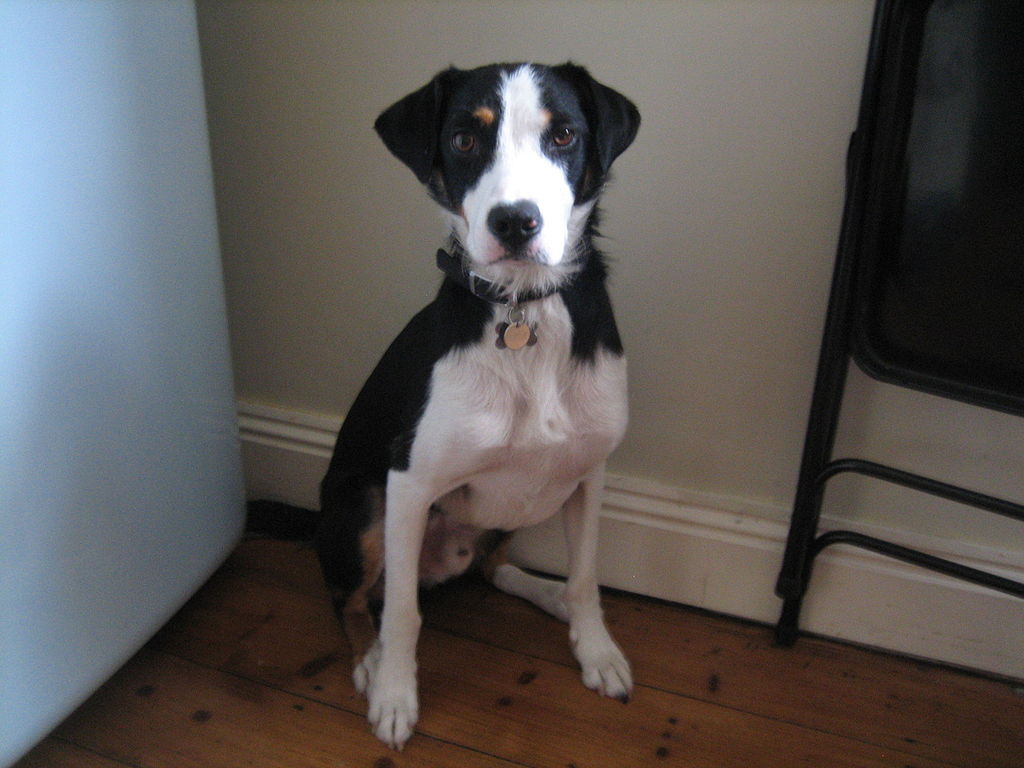 © Wikimedia.org/Kraig Donald, CC BY
© Wikimedia.org/Kraig Donald, CC BY
The Welsh Springer Spaniel (Welsh: Llamgi Cymru) is a breed of dog and a member of the spaniel family. Thought to be comparable to the old Land Spaniel, they are similar to the English Springer Spaniel and historically have been referred to as both the Welsh Spaniel and the Welsh Cocker Spaniel. They were relatively unknown until a succession of victories in dog trials by the breed increased its popularity. Following recognition by The Kennel Club in 1902, the breed gained the modern name of Welsh Springer Spaniel. The breed's coat only comes in a single colour combination of white with red markings, usually in a piebald pattern. Loyal and affectionate, they can become very attached to family members and are wary of strangers. Health conditions are limited to those common among many breeds of dog, although they are affected more than average by hip dysplasia and some eye conditions. They are a working dog, bred for hunting, and while not as rare as some varieties of spaniel, they are rarer than the more widely known English Springer Spaniel with which they are sometimes confused. (Source: Wikipedia.org, CC BY-SA)
 © Wikimedia.org/Udo Tjalsma, CC0
© Wikimedia.org/Udo Tjalsma, CC0
The Welsh Terrier (Welsh: Daeargi Cymreig) originates from Wales and was originally bred for hunting fox, rodents and badger; but during the last century, it has mainly been bred for showing. Despite this, it has retained its terrier strength of character. The Welsh Terrier has been claimed to be the oldest existing dog breed in the UK. The Welsh Terrier was a latecomer to the British show-ring (being primarily a working dog) and was not officially registered as a breed until the 19th century. It is on the UK Kennel Club's list of breeds that are in danger of dying out, having as few as 300 or so pups registered annually. The most popular breeds are registered in tens of thousands each year. (Source: Wikipedia.org, CC BY-SA)
The West Highland White Terrier, commonly known as the Westie, is a breed of dog from Scotland with a distinctive white harsh coat with a somewhat soft white undercoat. It is a medium-sized terrier, although with longer legs than other Scottish breeds of terrier. It has a white double coat of fur which fills out the dog's face, giving it a rounded appearance. The breed is intelligent, quick to learn, and can be good with children, but does not always tolerate rough handling. The Westie is an active breed, and is social with a high prey drive, as they were once used to hunt rodents. (Source: Wikipedia.org, CC BY-SA)
The West Siberian Laika or WSL, is a breed of spitz–type hunting dog. Russian publications indicate that the term West Siberian Laika loosely applied to hunting dogs originating with the Mansi and Khanty people in Ural and West Siberia, but there were no standards or registrations of WSL as such until 1930. Then WWII disrupted it for a while, but systematic breeding with registrations resumed after the war ended, in 1946. This was the time the breed began taking modern shape. Before that hunters only knew of Mansi Laika and Khanty Laika. In early 1960 many hunters in Ural still preferred the term Mansi Laika, when speaking of West Siberian Laika. In Russian language, the term Laika originated from the word layat that means to bark. The word Laika simply means barker. Any hunting Laika is a bark pointer (pointing at animal of interest by barking and staying with the animal ). It is a versatile dog depending on use and environment, but in certain parts of the country they have become more specialized. (Source: Wikipedia.org, CC BY-SA)
The Westphalian Dachsbracke is a small, short-legged scenthound, a breed of dog originating in Westphalia, a region of Germany. The Westphalian Dachsbracke was used in Sweden to develop the Drever. The Westphalian Dachsbracke (Westfälische Dachsbracke, German for Badger hound) is a small, short-legged version of the Deutsche Bracke, and very similar in size and appearance to the Drever (FCI No. 130), but 2 cm shorter (the Drever was first registered in Sweden in 1910 as the Westfälische Dachsbracke; the name was changed in 1947.) The Westphalian Dachsbracke stands about 30 to 38 cm (12 to 15 in) high at the withers. It has medium-long drooped ears, short legs, and a long tail which is set high and carried up. The coat has short fur, usually tricolor (red to yellow with a black saddle), with white markings called Bracken marks - a white muzzle, chest, legs, collar, and tip of the tail, and a blaze on the head. The chest is more narrow than the Dachshund's chest, and the legs are longer. (Source: Wikipedia.org, CC BY-SA)
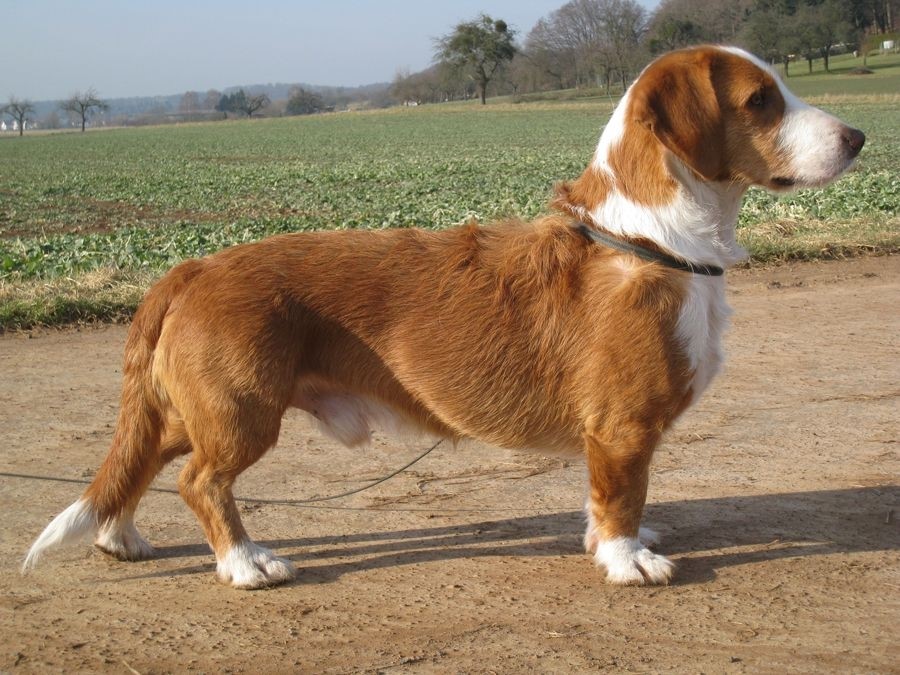 © Wikimedia.org/Volbu1, CC BY-SA
© Wikimedia.org/Volbu1, CC BY-SA
The Wetterhoun (translated into English as the Frisian Water Dog) is a breed traditionally used as a hunting dog for small game and waterfowl and native to the province of Friesland in the Netherlands. The name of the breed comes from the West Frisian Wetterhûn, meaning 'water dog'. The plural of Wetterhoun is Wetterhounen in Frisian. The breed may also be called the Otterhoun (not to be confused with the Otterhound) or Dutch Spaniel, although it is not a Spaniel-type dog. The Wetterhoun is a medium-sized dog, measuring at 55-59 centimeters (21.6-23 inches) at the withers and weighing between 25 and 35 kilos (55 and 77 pounds) at maturity. Their coat is thick and curly except for the head, ears, and legs, where it is smoother in texture; the water repellant coat is described as feeling oily to the touch. Coat colour may be solid black or brown, black and white, or brown and white, with or without ticking or roaning. The texture of the coat should not be woolly, as such hair is not water repellent. The ears are low-set and hang flat to the head, and the tail curls tightly over the back. The breed has an unusual, somewhat stern expression due to the shape of the eyes, which distinguishes this breed from others. (Source: Wikipedia.org, CC BY-SA)
The Whippet is a dog breed of medium size. It is a sighthound breed that originated in England, descended from the Greyhound. Whippets today still strongly resemble a smaller Greyhound. Part of the hound group, Whippets have relatively few health problems other than arrhythmia. Whippets also participate in dog sports such as lure coursing, agility, dock diving and flyball. The name is derived from an early 17th-century word, now obsolete, meaning 'to move briskly'. (Source: Wikipedia.org, CC BY-SA)
The White Shepherd is a variety of the German Shepherd bred in the United States. Although white-coated German Shepherds have been known in Europe as early as 1882, in 1933 the breed standard was amended in their native Germany, banning white-coated dogs from registration. In the United States and Canada the coloration had gained a following and in 1969 a breed club was formed specifically for white-coloured German Shepherds, calling their variety the White Shepherd. The variety is recognized as a separate breed by the United Kennel Club. (Source: Wikipedia.org, CC BY-SA)
 © Wikimedia.org/DanielBendig, CC BY-SA
© Wikimedia.org/DanielBendig, CC BY-SA
The White Swiss Shepherd Dog or Berger Blanc Suisse (German: Weisser Schweizer Schäferhund, Italian: Pastore Svizzero Bianco) is a Swiss breed of shepherd dog. It descends from North American White Shepherds imported to Switzerland; the White Shepherd itself descends from white-coloured purebred German Shepherds. The White Swiss Shepherd is of medium size, with a weight in the range 25–40 kg and a height at the withers usually between 53 and 66 cm.: 68 Two types of coat are seen, medium-length and long; the coat is always white, preferably with dark skin. The eyes range from light to dark brown and are almond-shaped; the ears are erect, forward-pointing, triangular, and slightly rounded at the tips. (Source: Wikipedia.org, CC BY-SA)
The dachshund (UK: /ˈdækshʊnd, -ənd, -hʊnt/ DAKS-huund, -ənd, -huunt or US: /ˈdɑːkshʊnt, -hʊnd, -ənt/ DAHKS-huunt, -huund, -ənt; German: 'badger dog'), also known as the wiener dog, badger dog, and sausage dog, is a short-legged, long-bodied, hound-type dog breed. The dog may be smooth-haired, wire-haired, or long-haired, and comes in a variety of colors. The standard-sized dachshund was developed to scent, chase, and flush out badgers and other burrow-dwelling animals. The miniature dachshund was bred to hunt small animals such as rabbits. According to the American Kennel Club, the dachshund was ranked 12th in popularity among dog breeds in the United States in 2018. (Source: Wikipedia.org, CC BY-SA)
The Wire Fox Terrier (also known as Wire Hair Fox Terrier or Wirehaired Terrier) is a breed of dog, one of many terrier breeds. It is a fox terrier, and although it bears a resemblance to the Smooth Fox Terrier, they are believed to have been developed separately. The Wire Fox Terrier is a sturdy, balanced dog weighing 7.7 to 8.6 kg (17 to 19 lb) for males and 6.8 to 7.7 kg (15 to 17 lb) for females. It should not be more than 39 cm (15+1⁄2 in) at the withers. Its rough, broken coat is distinctive. Coat color consists of a predominant white base with brown markings of the face and ears, and usually a black saddle or large splotch of color; there may be other black or brown markings on the body. (Source: Wikipedia.org, CC BY-SA)
The Wirehaired Pointing Griffon (also called the Korthals Griffon and the Griffon d'arrêt à poil dur Korthals in France and Quebec) is a breed of dog used in hunting as a gundog. It is sometimes considered to be Dutch in ancestry, due to the nationality of the breed founder, Eduard Karel Korthals. History records the progression of the development of the breed through Biebesheim am Rhein, Germany where the founder established the Ipenwoud kennel and the breed type was established and then into France where it is now recognized. Others consider the Griffon to be a German breed because Korthals' kennel, Ipenwoud, was located in Biebesheim am Rhein, Germany. It was there for over twenty years that Korthals dedicated his life to the development and perfection of the Korthals Griffon. (Source: Wikipedia.org, CC BY-SA)
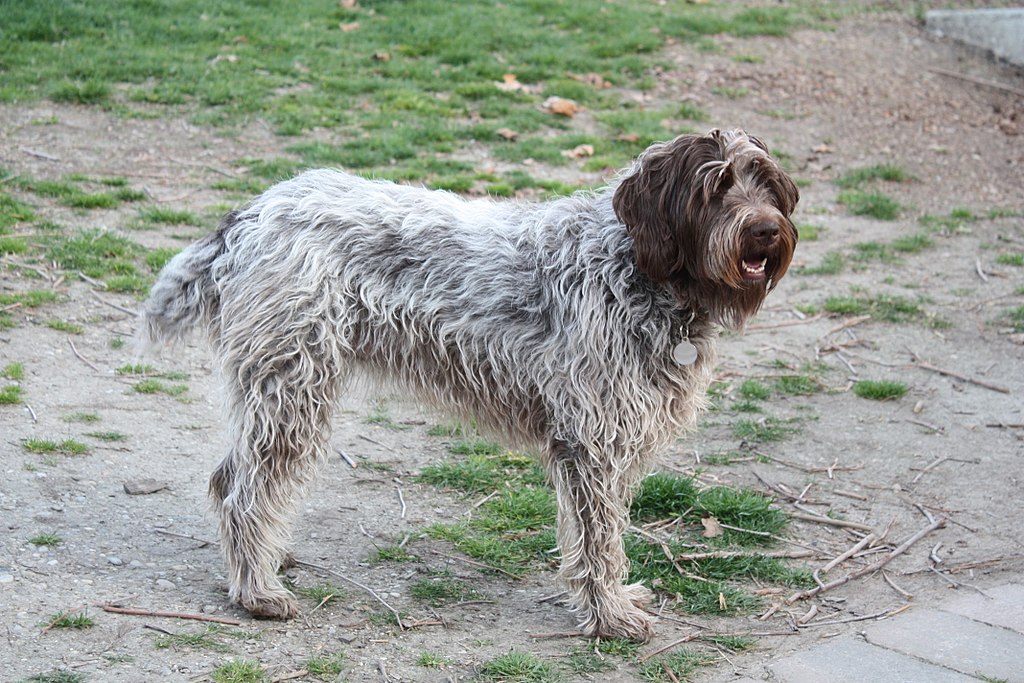 © Wikimedia.org/Liv klesta, CC BY-SA
© Wikimedia.org/Liv klesta, CC BY-SA
The Hungarian Wirehaired Vizsla (/ˈviːʃlə/ VEESH-lə; Hungarian: [ˈviʒlɒ]) is the English name of the Drótszőrű Magyar Vizsla, a dog breed originating in Hungary, with the name translating directly as Hungarian wirehaired pointer. The English plural is vizslas or sometimes vizslak, based on the Hungarian plural vizslák [ˈviʒlaːk]). The Hungarian Wirehaired Vizsla (HWV) is a versatile hunting dog that was traditionally and currently used to hunt, point, and retrieve, referring to the dog's natural ability in tracking, pointing, and retrieving game. The breed also has a level personality making them suited for families. The Wirehaired Vizsla is a versatile, natural hunter endowed with an excellent nose and an above average trainability. Although they are lively, gentle mannered, demonstrably affectionate and sensitive, they are also fearless and possessed of a well-developed protective instinct. The breed has a firmness on point, is an excellent retriever, and has the determination to remain on the scent even when swimming. (Source: Wikipedia.org, CC BY-SA)
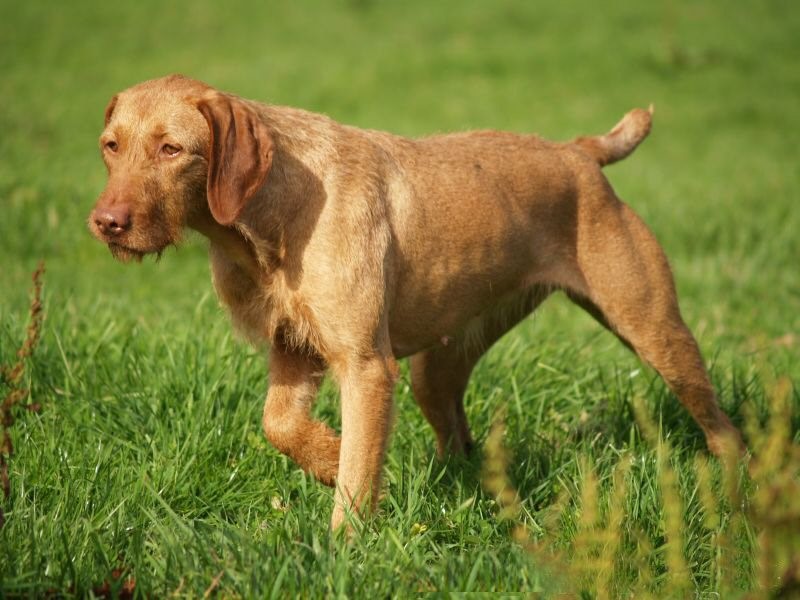 © Wikimedia.org/Noveczki Katalin, CC BY-SA
© Wikimedia.org/Noveczki Katalin, CC BY-SA
Xiasi Dog (Chinese: 下司犬) or Lower Division Dog is a breed of dog named after the village of Xiasi, Guizhou Province in China where they have been raised by the Miao people for thousands of years. Historically bred as a hunting dog and watchdog, the Xiasi Dog is prized today for bringing wealth to the family. Today the breed is critically endangered with low genetic diversity and an estimate of only 270 purebred Xiasi left. Xiasi Dogs are now accepted in most Chinese dog shows. Xiasi are white or cream in color with wiry hair and a pale pink nose. Their hair comes in three lengths: short, medium and long. Their head should be sizeable, the chest deep and round, and the tail should stick up. (Source: Wikipedia.org, CC BY-SA)
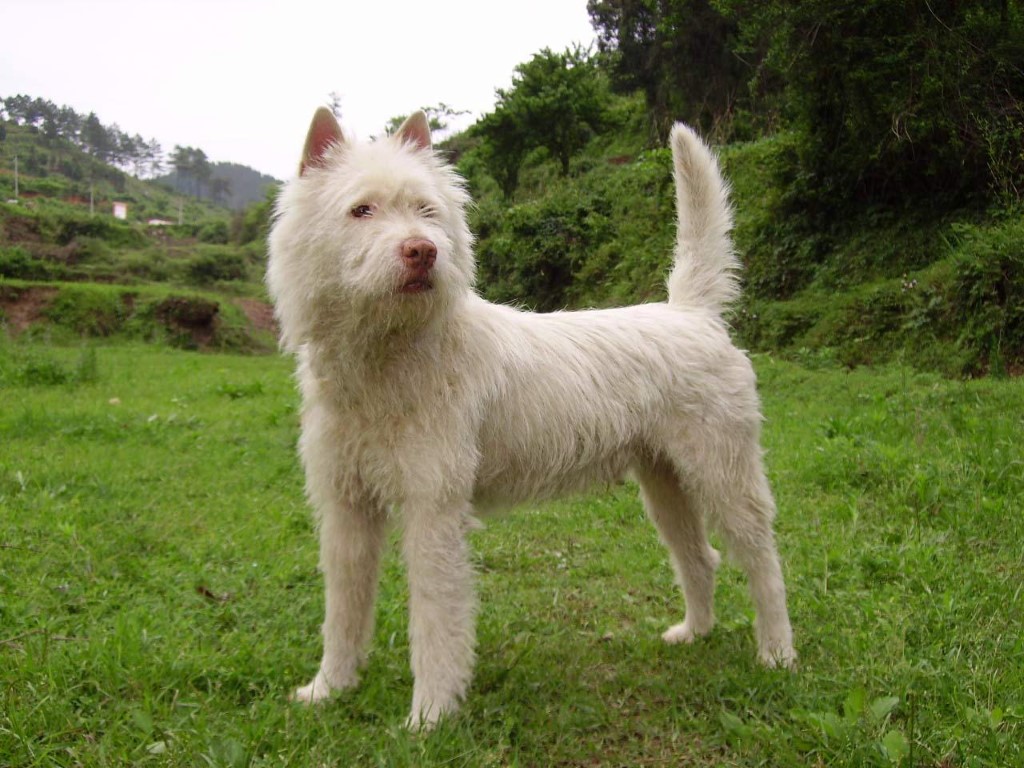 © Wikimedia.org/LauraKelsch, CC BY-SA
© Wikimedia.org/LauraKelsch, CC BY-SA
The Xoloitzcuintle (or Xoloitzquintle, Xoloitzcuintli, or Xolo) is one of several breeds of hairless dog. It is found in standard, intermediate, and miniature sizes. The Xolo also comes in a coated variety, totally covered in fur. Coated and hairless can be born in the same litter as a result of the same combination of genes. The hairless variant is known as the Perro pelón mexicano or Mexican hairless dog. It is characterized by its duality, wrinkles, and dental abnormalities, along with a primitive temper. In Nahuatl, from which its name originates, it is xōlōitzcuintli [ʃoːloːit͡sˈkʷint͡ɬi] (singular) and xōlōitzcuintin [ʃoːloːit͡sˈkʷintin] (plural). The name comes from the god Xolotl that according to ancient narratives is its creator and itzcuīntli [it͡sˈkʷiːnt͡ɬi], meaning 'dog' in Nahuatl language. (Source: Wikipedia.org, CC BY-SA)
The Yakutian Laika (Russian: Якутская лайка) is an ancient working dog breed that originated in the Arctic seashore of the Sakha (Yakutia) Republic. Yakutian Laikas are multipurpose laikas, with many lineages able to herd reindeer, hunt game and/or pull a sled. They are registered with the Russian Kennel Club, the FCI and the AKC's Foundation Stock Service in 2017. This is a versatile dog with excellent sense of smell, hearing and vision, strong hunting drive, endurance; they are aggressive to predators and soft and gentle to humans if properly socialized from young age. Whereas most aboriginal laika breeds are predominantly hunting dogs, the Yakutian Laika is predominantly a sled dog who also retain rudimentary hunting and herding abilities. (Source: Wikipedia.org, CC BY-SA)
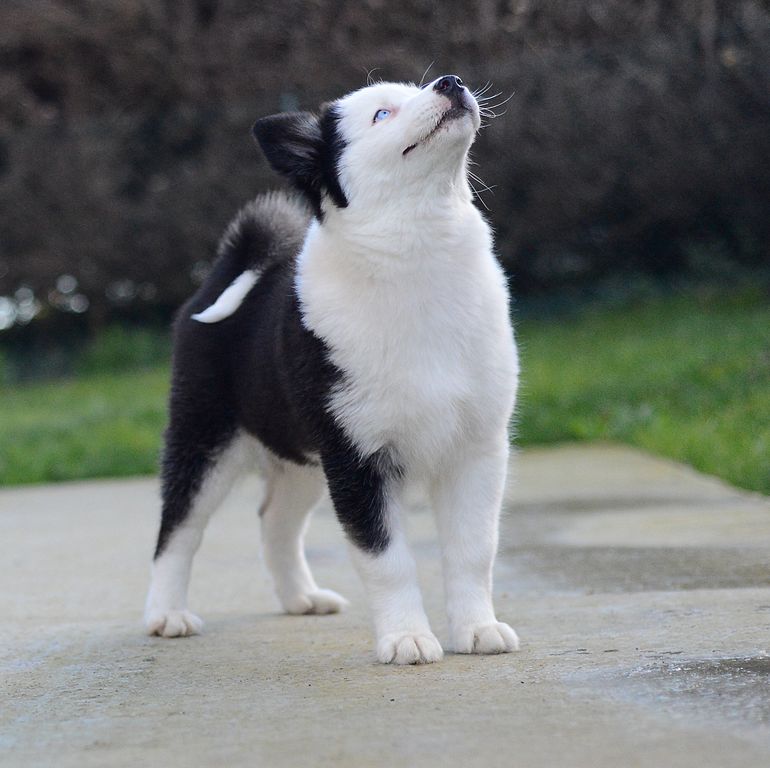 © Wikimedia.org/Pixelapache, CC BY-SA
© Wikimedia.org/Pixelapache, CC BY-SA
The Yorkshire Terrier (often shortened as Yorkie) is one of the smallest dog breeds of the terrier type and indeed of any dog breed. The breed developed during the 19th century in Yorkshire, England. Ideally its maximum size is 7 pounds (3.2 kg). A popular companion dog, the Yorkshire Terrier has also been part of the development of other breeds, such as the Silky Terrier. Most have a black and tan coat, but they are also known to have a silver-grey or a blonde coat. Yorkshire terriers are playful and energetic dogs. They often exhibit separation anxiety when left alone, which is a reason that some owners keep two dogs. (Source: Wikipedia.org, CC BY-SA)
The Zerdava, (Georgian: მეკვერნე) is an aboriginal laika dog breed native to Black Sea region of Turkey and Georgia. Zerdava are traditionally used as guard and hunting dog and are especially prized for boar hunting. The name “Zerdava” is Slavic for mustelid, possibly in reference to their Marten-brown color or their treeing behavior when hunting martens. Zerdava are a spitz breed with a compact, athletic body, triangular, upright ears and a curved tail. They have a double coat that is always liver brown or a combination of liver brown and white. The brown is described as marten-like in color, they may be solid liver or a combination of liver and white, such as liver and white-ticked except white tip of tail, piebald, ticked, or liver roan. At birth, the brown is often almost black in color and the white parts are without ticking. Zerdava will have brown noses and yellow-brown eyes. Their sickle shaped tails are usually white tipped and any brown spots will be the same shade of brown as the rest of their body. (Source: Wikipedia.org, CC BY-SA)
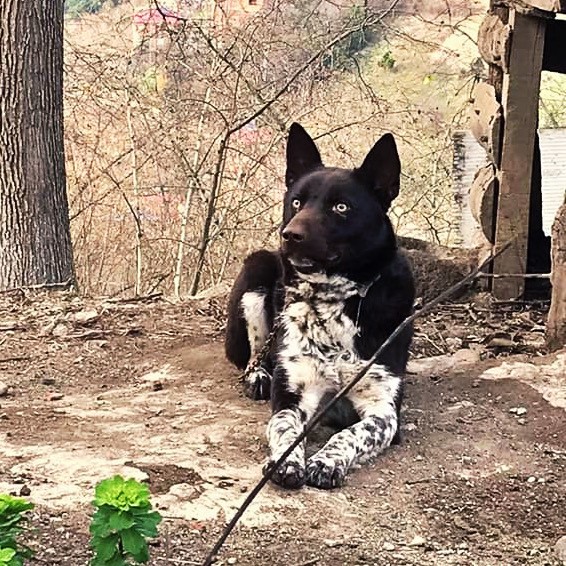 © Wikimedia.org/Annwfwn, CC BY-SA
© Wikimedia.org/Annwfwn, CC BY-SA

Time for recess! Post a comment, ask a question or write a review. Feel free to let us know what you think!
Пробовал пройти много раз. Всегда появляется варианты где есть два одинаковых ответа даже по несколько раз. Иногда угадывал какой. Но если угадывал через несколько вопросов опять появлялось такая ситуация и опять нужно было гадать. Эту ошибку нужно исправить, о то она показывает на некомпетентность ваших программистов. На самом деле если бы не эти глупые ситуации отвечал бы сотни раз подряд правильно на все вопросы. Видимо специально устроена такая подлянка чтобы расстроить человека который пытается пройти этот тест. Пропадает желание общаться с этой компанией.
В вопросе #9 дважды повторяется один и тот же ответ. В первом случае о фиксируется как неправильный,во втором случае как правильный.
Большое спасибо. Было интересно. Водила машину 40 лет тому назад. Можно ли В 70 лет сдать на права,интересно.
Этих вопросов на экзаменах в Японии нет, варианты билетов есть на сайтах японских автошкол там два ответа да или нет 10 вопросов, допускается 3 неправильных ответа
комент пользователя который прошол тест, тест дерьмо вопросы даже не близкие к реалистычным методом изключения прошол 3 раза на все 100% хотя в реальных условиях уже 2 раза не сдал
комент пользователя который прошол тест, тест дерьмо вопросы даже не близкие к реалистычным методом изключения прошол 3 раза на все 100% хотя в реальных условиях уже 2 раза не сдал
В тесте для вопроса "Что означает этот дорожный знак?" предлагаются два варианта ответа с одинаковым содержанием: "Предупреждение о сужении дороги слева." При этом один из них оценивается, как правильный, а второй - нет. Очевидно, один из этих вариантов должен был бы звучать: "Предупреждение о сужении дороги справа."
Что означает этот дорожный знак? Предупреждение о дороге с односторонним движением. Предупреждение о сужении дороги слева. Предупреждение о дороге с двусторонним движением. Предупреждение о сужении дороги слева. Второй и третий вариант одинаковые показывает ошибку, возможно во втором ответе должно быть написано слово «справа»
Я бы сказал бы тест отличный но просто перевод так себе не много путает особено два ответа одинаковые, а оно говорит не правильно хоть оба ответа правильные и еще некоторый перевод просто смешной и не поймешь, какой правильный ответ. Просто на угад, почему так смысл ответа размытый. А так отлично.
Переводчик решил пофантазировать на тему- скрещивания оленей, на самом деле предупреждение- будьте внимательны - ОЛЕНИ, их много в Канаде!
Тест хуйня так как такие дорожные знаки я не видел вот а сайт гавна взял и сам свои добавил всё
В пятом вопросе два раза написано сужение дороги слева, а нужно выбрать только один вариант - это описка или ловушка?
1. Предупреждение о сужении дороги слева. Два одинаковых ответа. 2. Парковка разрешева. При правильном ответе - защитывает ошибку.
ОТВЕТЫ НА НЕКОТОРЫЕ ПРАВЕЛЬНЫЕ ОТВЕТЫ ПОКАЗУЕТ НЕПРАВЕЛЬНЫЙ ОТВЕТ Б ТАКЖЕ ИПРИСУТСТВУЕТ НЕ ПРАВЕЛЬНЫЙ ПЕРЕВОД
Traffic-rules.com замечательный сайт! Я бы сказала самый лучший и самый удобный для изучения правил вождения автомобиля. Мне очень нравится.